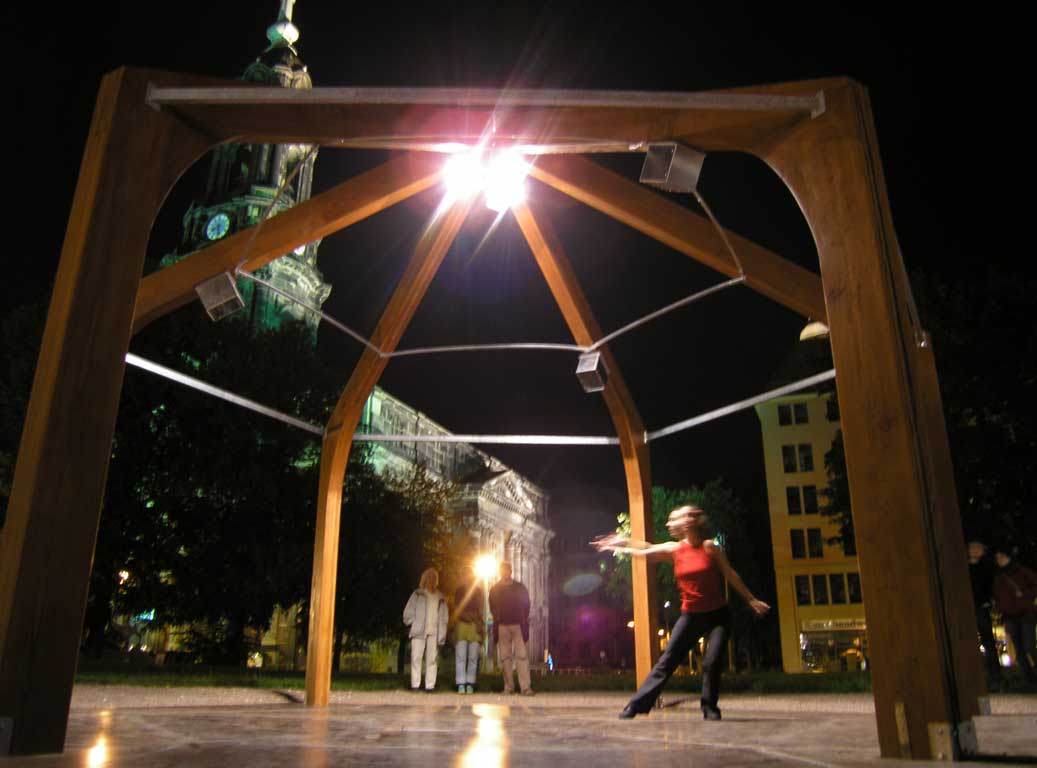interactive pavillon

„Enter - Move - Hear”, „Enter - Move - Explore”, „Enter - Move - Play”, „Enter - Move - Dance”, „Enter - Move - Interact”, „Enter - Move - Experience.” You should take those orientational demands into consideration while entering the recently opened “Interaktiver Pavillon” with a hexagonal interaction area. It opened in September 2005 in the direct neighbourhood to the Altmarkt Dresden. Since the opening of the first virtual place of the world culture (pilot project from July until November 2003), the TMA works on a computer-based interaction system with a worldwide extensible and linkable interaction area: The public room becomes an interactive stage not only for performance artists and dancers but also for passengers and for dance-willing people, for playing children, interested tourists or just for customers of the surrounding stores.
The "Interaktiver Pavillon" is on the contrary to its prototypical predecessor, the First Virtual Sqaure of the World Culture equipped with a permanently installed, globally controllable and linkable camera-motion-sensing system. It consists of a camera, computer, sound and network technology, which is controllable and linkable via the Internet and is linked with different electronic sound and image editing software and can be extended by video projection. The camera serves as a “frame” or “membrane” between the physical space and the virtual sound architecture in the cyberspace. The hexagon interaction area measures about 40 square meters and is spanned by six wooden frameworks five meters wide into the middle. As the test run of the first interactive “stage” in the public urban space, the new built "Virtueller Pavillon" is a publicly opened, multiple surrounding: Playing children, flatland-BMX and more or less move-willing or dance-willing visitors have quickly taken possession of the sensitive zone. Bicycles passing through will produce wild sound compositions, collective dance movements create their own sounds, body twists transform into special noise and groping gestures lead into many different worlds of sound.
The "Interaktiver Pavillon" is the first component in a network of Virtual Squares of World Culture and is being supported and built by Germany’s top-leading multimedia company T-Systems Multimedia Solutions in Dresden as well as the Telekom, the energy supplier DREWAG in Dresden and many other sponsors and partners in the centre of the Saxon art, science and high tech metropolis.
During different interactive performances and virtual installations in 2003, the artists from Europe or Australia were ought to be present in Dresden. But now the "Interaktiver Pavillon" can be visited from any place in the world and be linked with different virtual sound compositions and picture architecture via the special use of the software OSC-Network technology.
In February and May 2006, a workshop for art and media technology took place in Hellerau in cooperation with the City of Dresden with the aim to link the virtual places technically. The workshop raised conditions for a first pilot project "Virtuelle Landschaften" on the base of an OSC-Network control developed by Daniel Mühne in order to link two interactive places in Zgorzelec and Görlitz in the framework of the application for the European Culture Capital of both cities. Supported by the Theater Görlitz and the Dom Kultury Zgorzelec, an audiovisual interaction from citizens of both cities was realized successfully. The virtual environment was created by Holgart Herrmann, employee of the temporary TMA-Lab.
In the context of the 800th anniversary of the City of Dresden, temporary networks on the base of virtual environments by the artists Frieder Weiß and Holgart Herrmann have been established successfully between the "Interaktiver Pavillon" in Dresden and temporary interactive places in Görlitz and the partner city Coventry.
This is a field of work that could interest pupils and teachers, artists and scientists, younger and older people, Europeans or Asians in equal measure. There was hardly any field of possibilities that could link game, arts, music, theatre, science, technics, architecture, urban publicity, everyday life and personal, physical presence globally in such a simple and at the same time complex way. A transnational and transcultural network of this kind is all together, a huge cultural, artistical, scientifical, technical and ethnical challenge.
This method of interaction between coloured and white people, men and women, parents and children creates an environment as a space for or against communication, for or against personal development, for or against tolerance.
At a Sunday afternoon in September 2005, a three-year-old girl refused to leave the "Interaktiver Pavillon" despite of several demands from her parents. She turned, got onto the ground and was crawling right through the sound processes that was produced by her. She repeated it as many times as needed to get her mother asking her father to take her out of the scope. Another father followed the advice from his eight-year-old son. Both tried to make the hidden virtual space resound by different movements. By playing this “instrument”, they began to dance without noticing it…
Tags: eyecon, intele, Interaktiver Pavillon

